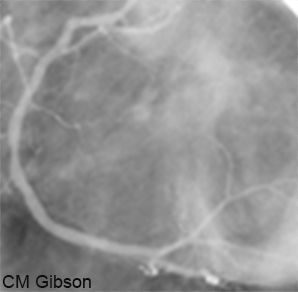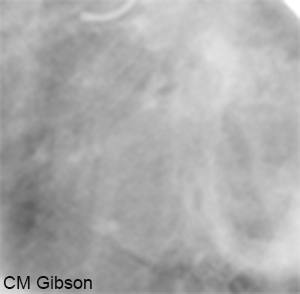TIMI myocardial perfusion grade 1: Difference between revisions
No edit summary |
No edit summary |
||
| (14 intermediate revisions by 3 users not shown) | |||
| Line 1: | Line 1: | ||
__NOTOC__ | __NOTOC__ | ||
{{Coronary angiography2}} | |||
{{CMG}} | {{CMG}} | ||
==Overview== | |||
== | |||
Dye slowly enters, but fails to exit the microvasculature. There is ground glass appearance (“blush”) or opacification of the myocardium in the distribution of the artery that fails to clear from the microvasculature, and dye staining is present on the next injection (approximately 30 seconds between injections). | Dye slowly enters, but fails to exit the microvasculature. There is ground glass appearance (“blush”) or opacification of the myocardium in the distribution of the artery that fails to clear from the microvasculature, and dye staining is present on the next injection (approximately 30 seconds between injections). | ||
| Line 15: | Line 9: | ||
Dye staining does not include arterial or venular stains. The TMPG should not be given a grade of 1 solely because either of the former are present, but only if myocardial or arteriole stains are present. | Dye staining does not include arterial or venular stains. The TMPG should not be given a grade of 1 solely because either of the former are present, but only if myocardial or arteriole stains are present. | ||
==Example== | |||
Shown below are a static image and an animated image depicting TIMI perfusion grade 1. | |||
[[Image:TMPG-1-static.gif]] | |||
[[Image:TMPG1_case_01.gif]] | |||
==Additional Examples== | |||
Click '''[[TIMI myocardial perfusion grade 1 case studies|here]]''' for other examples of TMPG 1. | |||
== | |||
==References== | |||
{{Coronary Angiography}} | |||
[[Category:Angiographic Definitions]] | [[Category:Angiographic Definitions]] | ||
[[Category:Cardiology]] | [[Category:Cardiology]] | ||
[[Category:Angiopedia]] | [[Category:Angiopedia]] | ||
{{WikiDoc Help Menu}} | {{WikiDoc Help Menu}} | ||
{{WikiDoc Sources}} | {{WikiDoc Sources}} | ||
Latest revision as of 15:27, 13 November 2013
|
Coronary Angiography | |
|
General Principles | |
|---|---|
|
Anatomy & Projection Angles | |
|
Normal Anatomy | |
|
Anatomic Variants | |
|
Projection Angles | |
|
Epicardial Flow & Myocardial Perfusion | |
|
Epicardial Flow | |
|
Myocardial Perfusion | |
|
Lesion Complexity | |
|
ACC/AHA Lesion-Specific Classification of the Primary Target Stenosis | |
|
Lesion Morphology | |
Editor-In-Chief: C. Michael Gibson, M.S., M.D. [1]
Overview
Dye slowly enters, but fails to exit the microvasculature. There is ground glass appearance (“blush”) or opacification of the myocardium in the distribution of the artery that fails to clear from the microvasculature, and dye staining is present on the next injection (approximately 30 seconds between injections).
Dye staining does not include arterial or venular stains. The TMPG should not be given a grade of 1 solely because either of the former are present, but only if myocardial or arteriole stains are present.
Example
Shown below are a static image and an animated image depicting TIMI perfusion grade 1.
Additional Examples
Click here for other examples of TMPG 1.

